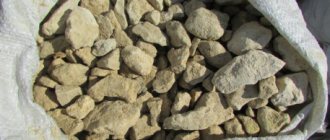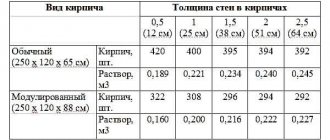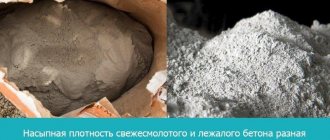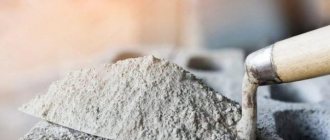The particular popularity of such building material as sand concrete is due to its strength and durability. The method for producing such mixtures is quite simple; the components are freely available and inexpensive. Thus, the use of sand concrete is economically beneficial both for masonry of brick, cinder block and other materials, and for plastering various surfaces.
The basic method for calculating the required amount of sand concrete mortar
- a special chemical substance that has high strength and astringent properties - first grade Portland cement;
- sand with a fraction size of no more than 3 millimeters;
- plasticizers, which have the properties of increasing moisture resistance and strength of building materials;
- In order to improve the properties, granite powder is added to the solution.
How many bags of sand concrete are in 1m3? The mixtures are sold in prepackaged packages weighing 25, 40 and 50 kg. This building material is a type of heavy concrete, for this reason the mass of one m3 is approximately 2.4 tons. Using special calculations, when the consumption of sand concrete is 20 kg per 1 square meter, with a layer thickness of 1 cm, then the quantity is calculated using the following formula:
- the volume of a forty kilogram bag is divided by 20 kg, resulting in 2 cm. In order to process 100 cm/2 cm of area, 50 bags will be needed;
- if the volume is 50 kg, then in order to treat an area of 1 m2 you will need 40 packages.
Before determining the required amount of sand concrete per 1 m3 of solution, it is recommended to take into account the condition of the surface layer, the required mixture proportions and the thickness of the coating.
It is recommended to determine this using the following parameters: 1 m3 of sand concrete has a weight of 2400 kg, which must be divided by the package weight of 40 kilograms. The total is:
- 0.010 cubic meters in a 25 kg sand concrete bag;
- 0.017 cubic meters in a 40 kg sand concrete bag;
- 0.021 m3 per 50 kg package.
- 2.4 g/cm3;
- 2.4 t/m3;
- 2400 kg/m3.
Working with the M150 requires compliance with certain rules. But they are no different from the procedure for using other building mixtures of this type.
We invite you to familiarize yourself with roofing felt for foundation waterproofing: features and choice
If this is a wall, then it must be completely freed from dust and dirt, plant debris, etc.
Cleaning the wall
Removing old plaster
But for this it needs to be prepared. For plastering walls, the proportion is as follows: for 10 kg of M150, 2 liters of water. It is advisable to take it clean and cold, but not very cold, about 15 C. If necessary, you can add more liquid.
The solution is made like this. The mixture (dry) is gradually added to the water and mixed. When the mass becomes homogeneous, let it stand for about 5 minutes. And then it must be quickly mixed again. The batch should be worked out within 2 hours.
Preparing the mixture
When applying plaster to the surface, it is necessary to cover all cracks and holes, if any, with it. And only after that level the entire surface. As a rule, the solution itself is applied with a spatula and leveled with a grater.
Application with a spatula
Application to reinforcing mesh
M150 is considered a universal brand among similar cement-sand mixtures. It behaves well during various technological operations. This mixture, if necessary, can replace any other. That is why it is in demand in the construction market.
Specific gravity of sand-cement mixture
Today, cements are produced with low and high densities. The second type is characterized by substances that do not contain additives. The specific gravity of sand-cement materials, the production of which used plasticizers or other additives, is determined taking into account their percentage. The advantages of a low-density cent are the use of a large volume mixture. But this material has a main drawback - high porosity.
To determine the bulk density of a material, you must be guided by its brand.
When using brands such as:
- M100, M150 and M200 density averages 900 kg/m3.
- For brands such as M300, M400 and M500, the specific gravity will be 1100 kg/m3.
If we consider the cement of the most common grades, then the bulk density for sand-cement mortars will reach 1700 kg/m3, and for cement-perlite mortars – 100-1400 kg/m3. The density value can be adjusted during production. To do this, it is necessary to increase the amount of ferrous phase content or simply add barium oxide. Most often, when performing construction work, cement grades such as M200, M300 and M400 are used.
You can learn about the technical characteristics of cement-lime mortar M 75 from this article.
M-200
This brand is in great demand in the construction of floors, foundations, floor screeds, and installation of building structures. The M200 marking indicates that the ability of the frozen mass can withstand loads of about 200 kg/cm2.
This material falls into the light category. The presence of low density indicators is due to the presence of hollow fillers. The value of the mass here is influenced by the ratio of water, sand, crushed stone and other ingredients. The specific gravity for this material will reach 1500 kg/m3. To make M200 you must use:
- one part M400 or M500;
- water, the amount of which is determined at the rate of 40 liters per 10 kg of mixture;
- 28 parts clean sand;
- 48 parts of gravel, crushed stone.
How to use cement-sand mortar GOST 28013 98 can be found in this article.
M-300
This material has a wide range of applications. They are actively used in laying road surfaces, pouring mains, and constructing airfield pavements. For such material, the density indicator is 1800 kg/m3.
To obtain this composition it is necessary to use the following components:
- 1 part of cement M500 or M400;
- 19 parts sand;
- marble, gravel or limestone filler – 35 shares
- ;water is taken at the rate of 30 liters per 10 kg of material.
You can learn how to preserve cement until next year from this article.
The presented brand of cement is characterized by the fact that light fillers give a share of density to heavier particles. As a result, M300 falls into the category of medium-density materials. The density of M500 cement will be significantly higher.
M-400
This material has proven itself in creating durable and moisture-resistant coatings. The material of this brand is characterized by rapid hardening and high resistance to mechanical influences. Also, the M400 brand is included in the category of heavy mixtures. It is worth special mentioning Portland cement M400.
To prepare M400 cement, the following components are used:
- M500 – 1 part;
- 12 parts clean sand;
- 27 parts of medium fraction crushed stone;
- water is taken in the following quantity: 25 liters per 10 kg of material.
You can find out how many bags of cement are in one cube of concrete from this article.
The specific gravity of cement is a very important indicator, thanks to which it is possible to correctly calculate the proportions of all components used. Each brand of cement has its own number. This indicator is greatly influenced by the fillers that are used to obtain the dry mixture.
To find out how much sand, crushed stone, cement is in a cube of concrete, you need to read this article.
When choosing a material, it is very important to pay attention to all these parameters in order to purchase a quality product.
Compound
Sand concrete M200 contains several components in certain proportions - all of this is regulated by GOST 31357-2007. Manufacturers are allowed to make minor adjustments to the composition of the dry mixture to improve properties and achieve the desired characteristics, but the main components and their volumes (as well as the exact parameters) must remain unchanged.
Components included in sand concrete M200:
- Portland cement grade M400
- River sand of fine and coarse fractions - always thoroughly cleaned of impurities beforehand
- Fine crushed stone
- Water
- Additional dry mixtures – plasticizers, additives, special substances
Consumption of M200 sand concrete per cubic meter:
- 265 kilograms of Portland cement - 1 part
- 860 kilograms of sand – 2 parts
- 1050 kilograms of crushed stone – 5 parts
- Approximately 180 liters of water - volume may vary
What to consider when calculating
To calculate how many bags of cement are in a cube of concrete, you need to take into account the following parameters:
- design strength of concrete;
- ;
- packaging size;
- aggregate fraction;
- proportion of components.
The composition for preparing the concrete mixture is regulated by Building Codes and Rules 5.01.23-83. The document indicates the recommended grades of Portland cement to obtain a monolith with the required characteristics.
For individual construction, concrete is used:
- M100 - for installing cushions under foundations,
- M150 - pouring paths, blind areas, floor screeds, bases for sheds, garages, gazebos, installing curbs, fence posts;
- M200 - production of monolithic foundations, lintels, floor slabs, columns and walls.
In accordance with the brand of the monolith, the consumption of the binder is normalized.
Cement brand
The main characteristic that needs to be taken into account when purchasing is the brand of cement. It determines the strength characteristics of the binder component. The higher it is, the less consumption of this material.
In individual construction, the most used are PC grades 350-500.
Areas of application of Portland cement:
- M200, M300 - finishing work;
- M400, M500 - monolithic foundations, walls and other building structures.
You need to pay attention to freshness - strength decreases with long-term storage. According to GOST rules, the shelf life of PC is 1 year from the date of manufacture
Fillers
depends on the size of the coarse aggregate - crushed stone, gravel and fine - sand. The standards provide for the use of increasing and decreasing coefficients when fraction sizes deviate upward or downward.
If the size of the crushed stone is less than 20 mm, the amount of binder is increased by 10%, otherwise it is reduced by 5-10%.
The sand fineness modulus is taken into account:
- if it does not exceed 1.5, the PC consumption is increased by 12%;
- up to 2 - by 5%.
Where is it used?
Sand concrete M200 has a good composition, so the mixture is used quite widely - in various fields to implement many tasks. The solution demonstrates a high drying rate and minimal shrinkage, therefore it is most relevant in low-rise construction of industrial/domestic premises, in finishing and installation work.
Where is sand concrete M200 used:
- Concreting of various structures that are not expected to be exposed to too heavy loads
- Masonry of different types of blocks and bricks
- Sealing gouges and cracks
- Pouring the foundation
- Work on leveling floors, walls, ceilings, grouting joints between blocks
- Preparation and filling of floor screeds (especially important for heated floors)
- Filling walls and other vertical structures
- Landscaping of the local area - filling of pedestrian paths, garden paths
- Restoration of various surfaces
The mortar (sand concrete M200) can be laid in a thin or thick layer on horizontal/vertical surfaces. Thanks to the composition of the mixture, it is possible to significantly improve the technical characteristics of buildings and guarantee the reliability and durability of structures.
Purchase of the required volume of powder and necessary building materials
The Group meets all consumer and technical requirements in its activities. Having looked at the calculation schemes and recommendations within the article, you can know what proportion of cement powder is in the mixture used when installing walls or pouring the foundation when a house is being built. Then go to the “Contacts” section to order high-quality building materials from the best manufacturers.
Having calculated how much powder building material is needed, leave a request or call (feedback works) to discuss the details of the purchase. Competent managers will answer any of your questions. In our activities, we fulfill our obligations and also unconditionally respect the rights of our clients. A detailed site map and product catalog will help you find out what of our products you can get for construction.
Thus, when working with AlfaCem, you will not only be able to buy the best building materials, but also easily take advantage of professional advice on how much cement 1 cubic meter of the mixture contains, provided that it is carried out under different initial parameters. We wish you success!
Current SNiP or old-fashioned method
The current rules give a fairly clear answer to the question of how much cement per cube of mortar may be needed. At the same time, calculations usually take into account not only the optimal volumes of components, but also their characteristics: fraction, purity, humidity, density, quality, etc.
When studying the norms of material consumption per cube of concrete, you should also take into account the conditions in which you plan to carry out the work. Thus, SNiP assume that concrete mixing and work are carried out at an ambient temperature of +23 degrees, under conditions of average humidity levels. All components must be clean and have a maximum moisture content of 7%.
In the tables you can find the following data:
When preparing concrete, it is important to calculate how much crushed stone and sand is needed per 1 m3 of solution, since the strength, reliability, durability of the monolith and other important characteristics depend on these components.
The table shows the consumption of sand and crushed stone:
When preparing concrete, you should remember that everything can be calculated based on the total weight of a cubic meter of solution. But that's not true. Given that the cement is extremely finely ground and fills the voids between the sand grains, it may not increase the overall volume of concrete. So, by adding 200 or 400 kilograms of cement, the volume of solution (1 cubic meter) is obtained the same.
Volume of cement in a bag (25 kg, 40 kg, 50 kg): calculation and table
There is no need to buy extra cement. When stored for a long time, even in a dry room, it loses strength. In a year it will be 50% of the nominal value. That is why when purchasing it is worth knowing how much binder is required. But there may be problems here. Proportions for concrete mortar are often given in volume fractions, and cement is sold by weight, packaged in bags. Calculations may require the volume of cement in the bag. You can use the average and calculate approximately.
Cement bag volume
In general, the question of how much cement is contained in a bag is not so easy to answer. Let's start with the fact that packaging comes in bags of 25 kg, 40 kg and 50 kg. So we need to clarify the mass. The second point is that cement comes in different forms. With or without additives. And additives also come in different types, and different types differ in density. This means that the same weight occupies a different volume.
The weight of a bag of cement can be 25 kg, 40 kg and 50 kg
There is one more point. The density of any cement changes over time. Immediately after production, when it was poured into bags, the density is the lowest. As the ground powder is poured in, the particles become charged and capture air molecules. Therefore, freshly poured it weighs less. During transportation and storage, the charge decreases, some of the air evaporates, and the density increases. So after a month more weight is placed in the same volume. Moreover, after about a year of storage, the difference with the bulk density is significant - up to 35% of the original value.
In the calculations, an average figure is taken, which is called specific density. For each type of cement it is different and in calculations when determining the amount of material required, you can build on it.
Calculation method
The specific density of cement is the mass of one cubic meter. For Portland cement, for example, it is 1300 kg/m³. To determine the volume of cement in a 50 kg bag, you need to solve a simple proportion:
How to calculate the volume of cement in a bag
We found what percentage of one cubic meter is contained in one 50 kg bag of Portland cement. This is 3.85%. This means that this container contains 0.0385 m³ (we simply “take a percentage” of the cubic meter).
Pivot table
For a bag of 25 kilograms, you can not count, but divide the resulting figure by two. One 25 kg bag of Portland cement contains 0.019 m³. For a 40 kg bag, you will have to calculate everything again. The result is 0.031 m³. Similar calculations must be done for all brands of cement with different densities. We did this and compiled the data into a table.
Volume of cement in a bag: table for different containers and different brands of binder
The table contains average values. If you know exactly the weight of a cube of your material (it can be indicated on the bag or you can weigh it and calculate it), it is better to recalculate. The difference is unlikely to be big, but still. How to calculate? Take a liter container, put it on the scales and weigh it. Pour cement - do not shake, do not compact. Just pour and weigh, and then take away the container weight. You will find how much a kilogram of cement you purchased weighs. Then you multiply by 1000 (one thousand liters in one cube) and you get the exact (almost) density of your material. You can use it later in calculations.
How much concrete will be produced from a bag of cement?
Often proportions are indicated in volume fractions and therefore, when making calculations, it is useful to know how much concrete can be made from one bag of cement. But we need to talk about a specific brand and a specific concrete solution. The proportions are different and you need to decide on this first. The difference is significant - this can be seen from the following table.
How much concrete will be produced from 10 liters of cement?
For each binder and each brand, you will again have to count separately. For each concrete, the approximate consumption of cement for the production of one cube of mortar is known. Based on these data, you can calculate how much solution can be obtained from a kilogram of cement. Next, it is easy to find out the amount of concrete that can be obtained from a bag of cement.
Binder consumption by concrete grade
For example, a cube of M300 concrete requires 350 kilograms of M400 cement. That is, from one kilogram we get 1 m³ / 350 kg = 0.0028 m³. To find out how much M400 concrete you can get from a 50 kg bag, multiply by 50. We get 0.14 m³. As you can see, the calculations are simple.
To consolidate the information, let’s calculate for M200 mortar and the same M400 Portland cement. This type of concrete requires 250 kg. Then from a kilogram we get 1 cubic meter / 250 kg = 0.004 cubic meters. Then from 50 kg it will be: 0.004 * 50 = 0.2 cubic meters, from 40 kg - 0.004 * 40 = 0.16 cubic meters.
Peculiarities
Sand concrete is often referred to as an intermediate element between cement and concrete mixture. Dry material is often used for restoration, repair and construction work. It is lightweight and easy to work with, does not shrink, and has proven itself well on unstable soils. Sand concrete M200 is indispensable in the construction of concrete floors where serious loads are noted - garages, warehouses, shopping centers.
The mixture contains crushed stone and chemical additives, which ensures that the material does not shrink even with a fairly thick layer. Strength can be increased by using plasticizers, as well as ensuring sufficiently high frost resistance.
When adding various additives (especially to impart workability to the mixture), it is necessary to correctly determine the optimal volume in order to ensure the desired consistency without compromising the strength characteristics.
Pigments give sand concrete the desired color - there is also quite a wide variety here. The main thing is to choose the right supplement and work according to the instructions.
Number of bags of cement in 1 m3 of ready-made cement mortar
By analogy with considering the question of how many bags of cement are in a cube of concrete, let’s first ask ourselves the initial data:
- Cement-sand mortar grades: M75, M100, M150, M200.
- Portland cement CEM I 32.5N PC (M400) and CEM I 42.5N PC (M500), packaged in multilayer paper bags.
- Net weight of bags: 25, 50 kg.
To determine the value - how many bags of cement are in a cube of mortar, we will use tables of proportions of concrete components in kilograms, compiled by analogy with tables of proportions of components for preparing concrete.
Table of proportions and quantities of components per 1 m3: Portland cement CEM I 32.5N PC, sand, water
| Concrete grade | Proportion, C:P:W | Cement, kg | Sand, kg | Water, l |
| M75 | 1:5:1 | 285 | 1390 | 285 |
| M100 | 1:4:0,8 | 338 | 1345 | |
| M150 | 1:2,8:0,6 | 450 | 1265 | |
| M200 | 1:2:0,5 | 560 | 1185 |
Table of proportions and quantities of components per 1 m3: Portland cement CEM I 42.5N PC, sand, water
| Concrete grade | Proportion, C:P:W | Cement, kg | Sand, kg | Water, l |
| M75 | 1:5,5:1,1 | 260 | 1405 | 285 |
| M100 | 1:4,5:0,9 | 305 | 1375 | |
| M150 | 1:3,3:0,7 | 400 | 1300 | |
| M200 | 1:2:0,5 | 495 | 1230 |
An example of calculating the value is how many bags of cement per 1 cubic meter of M200 solution based on Portland cement CEM I 42.5N PC: 495/50 = 9.9 bags weighing 50 kg; 495/25=19.8 bags weighing 25 kg.
Answers to other common questions from private developers
- How many cubes are in a 50 kg bag of cement and how many cubes are in a 25 kg bag of cement? The average specific gravity of 1 m3 of cement, accepted by all concrete plants as a value for practical calculations, is 1,300 kg/m3. Accordingly, in a 50-kilogram bag of cement: 50/1300 = 0.038 m3 of cement, and in a 25-kilogram bag: 25/1,300 = 0.019 m3 of cement.
- How many cubes of concrete can be obtained from a bag of cement weighing 50 or 25 kg? The number of cubes of concrete that can be prepared from the specified bags of cement depends on the brand of concrete. Let's consider as an example the most popular brand of concrete - M200 based on CEM I 32.5N PTs cement. To calculate using the table value of the amount of M400 cement required for the preparation of concrete grade M200 - 255 kg. We compose and solve the proportion: 50 kg x 1 m3/255 kg = 0.19 m3 and 25 kg x 1 m3/255 = 0.098 m3 of concrete, they will be 50 kg and 25 kg of a bag of M400 cement, respectively.
Similarly, using the above tabular data, you can calculate how many cubic meters of cement-sand mortar a bag of cement weighing 50 and 25 kg will be enough for.
Tips for purchasing and using sand concrete
When using sand concrete, it is recommended to follow a few simple rules:
- the material must be used strictly for its intended purpose, therefore it is extremely important to select the appropriate brand of sand concrete;
- calculate in advance the required amount of material;
- You should only buy material from a reliable supplier;
- too low price of sand concrete may indicate handicraft production;
- use only fresh mixtures;
- Before pouring the mixture, the surface must be thoroughly cleaned and prepared.
When choosing the optimal sand concrete characteristics, you should take into account the brand of sand concrete and the manufacturer. You can order sand concrete directly from a concrete plant in Moscow, which will ensure ease of work and high quality results. Other advantages of ordering products from our company include:
- the best price of sand concrete per bag or cube;
- use of modern equipment that guarantees accurate dosage and thorough mixing;
- quality certificates for all brands of sand concrete produced;
- fast delivery of any volumes.
When ordering sand concrete from our company, you can count on high quality products, favorable prices and professional service.
You can order sand concrete in Moscow, get professional advice on calculating sand concrete consumption and choose the right brand by phone - our engineer will answer your questions, calculate the cost of delivery and fill out an application.
How many cubes in a 50 kg bag of cement
Cement is one of the most popular building materials. It is produced in standardized packaging of 25, 40 and 50 kg. But for the convenience of construction work, incl. To simplify the selection of proportions in building mixtures, it is sometimes necessary to know how many cubes of material are in such a 50 kg bag.
Determination of cement volume
To obtain the volume of a package of a certain weight, you need to know the density of the material. It varies depending on the brand and composition features (exact proportions of components, additive content, presence of impurities, etc.). In most cases, the manufacturer indicates this data on the product packaging or in the accompanying documentation. The indicator can also be clarified in reference books or on the Internet. If a perfectly accurate calculation is not needed, then use the average figure of 1300 kg/m3.
Next, the weight of the bag (in this case 50 kg) must be divided by the density of the material. For example, for cement with a density of 1250 kg/cubic meter, the volume of the bag is 50 kg/1250 kg/m3, i.e. about 0.04 m3.
Features of density determination
If we take all the initial components used for the production of cement, their volume will be significantly less (about 1.5-2 times) than that of the ready-made powder. This is due to the fact that when grinding these components and mixing with each other, air gaps take up quite a lot of space. Therefore, one should distinguish between true density (i.e. in an absolutely dense state) and bulk density (taking into account pores and air between the particles of the material). It is the latter that is indicated by the manufacturer on the packages and is used in calculating their volume.
Fresh cement is characterized by the lowest density (on average about 1100 kg/m3), in other words, a large volume with less weight. Then, over time, it tends to cake, and for material stored for several months, this figure is higher (reaches 1500-1600 kg/m3) than for material recently released; accordingly, the volume of such a bag will become smaller.
If we are not talking about pure cement, but about various mixtures containing it - cement-sand mortar, concrete, etc., then we should take into account the proportions of cement relative to other components and their density indicators, and only on this basis calculate how many cubes This or that mixture will be obtained using a package of material weighing 50 kg.
Criteria for choosing sand concrete
The main indicator of sand concrete is strength. It is designated by the letter M and the number 50, 75, 100 and then in increments of 50. In modern construction, sand concrete M50 and M75 is practically not used.
- M100 is used in rooms with a light load on the floor, covered in the form of linoleum or carpet. Sometimes it is used for plastering walls.
- For floors covered with laminate, various types of tiles and parquet boards, it is recommended to use sand concrete marked M200 or M250.
- If a heated floor is laid in the room, it does not matter whether it is water or electric, then the sand concrete should be at least M250, or even M300.
- M300 is also used in cases of high loads on the screed, for example, in a garage. It is used for laying foundations, paths in the garden, and open parking.
For private construction, denser sand concrete is not required. Of course, it won’t get worse, but the cost of concrete increases depending on its strength, and during construction and repairs there is no need for extra expenses.
The mixture is distinguished depending on its properties and scope of application:
- Waterproofing sand concrete can be used in rooms with high humidity - bathrooms, swimming pools, saunas.
- Assembly sand concrete is used for plastering or fastening masonry.
- Sand concrete with increased wear resistance is used for foundation work and floors where there will be a high load.
The most common sand concrete is universal, which can be used for different jobs.
Universal formula for calculating the number of cubes of cement in a bag
Due to the fact that crushing and mixing operations are used in the production of cement, the mixture of components is enriched with air, and the particles are magnetized and repelled as a result of friction. As a result, the final product in the package has a large volume of air (up to 50%). Mixing is carried out in a special tank. The mixture is removed from the container using pneumatic blowing. During storage, cement is compacted, its density is about 1600 kg/m3. The volume in the container decreases. The density of cement in a bag varies from 900 to 2000 kg/m3 depending on the degree of looseness of the mixture. It should be noted that during storage of the cement mixture, the physical state changes depending on the looseness. The density during the research turned out to be 1000 kg/m3 in a loose state. An accurate calculation of the volume of cement is necessary to determine the mixing proportions. The measuring quantity when calculating the ratio of components is volume. The volume of freshly mixed cement has the lowest density, up to 1100 kg/m3. The average specific gravity is 3 kg/m3. The density of cement during the preparation of concrete mixture varies up to 1300 kg/m3. This figure is usually taken into account when calculating the cubic volume; it is regulated by the All-Union Standards for Technological Design of Prefabricated Reinforced Concrete Enterprises (ONTP-07-85), approved by Order of the USSR Ministry of Industry and Construction No. 810 of December 20, 1985
To calculate the number of cubes of cement in one bag, a universal formula is used: Number of cubes in 1 bag, m3 = (Weight of the bag, kg)/(Average density, kg/m3) The brand of cement for preparing the solution should be taken into account. Modern manufacturers of building materials supply consumers with cement to perform various types of work.
Data on the density of the cement mixture is indicated on the packaging. The manufacturer places data on the density of bulk cement on the container, that is, taking into account air gaps. When producing concrete, it is recommended to take into account the exact ratio of the components. In this case, the amount of cement will vary depending on the type of concrete being prepared, the technology and the brand of the batch.
How many cubes in a 50 kg bag of cement
To determine the number of cubic meters in a 50 kg bag, a universal formula is used: Number of cubes in 1 bag, m3 = (50 kg)/(1300 kg/m3) = 0.038 m3 or 38 liters. The generally accepted value or the exact number on the container specified by the manufacturer is used as the density value.
How many cubes are in a 40 kg bag of cement?
To calculate how many cubes are in a 40-kilogram bag of cement, we substitute the values into the formula: Number of cubes in 1 bag, m3 = (40 kg)/(1300 kg/m3) = 0.031 m3 or 31 liters. The value generally accepted from GOST or the exact density figure indicated by the manufacturer on the packaging is used as the density value.
How many cubes are in a 25 kg bag of cement?
To determine the number of cubic meters in a 25 kg bag, a universal formula is used: Number of cubes in 1 bag, m3 = (25 kg)/(1300 kg/m3) = 0.019 m3 or 19 liters. The average value of cement density is accepted, based on regulatory documents, or the value indicated on the packaging. For example, to prepare a solution for pouring concrete into a foundation, the volume of the trench to be poured is calculated. It should be noted that the final figure for the volume of concrete will be greater, so we add another 10% to the resulting number. Using 50 kg bags of cement for mixing simplifies the calculations. To obtain 1 cubic meter of concrete you will need cement: M100 - 166 kg; M200 – 241 kg; M300 – 319 kg; M400 – 417 kg. Calculating the volume of cement in bags taking into account density will allow you to calculate the exact proportions for mixing concrete with the required characteristics.











